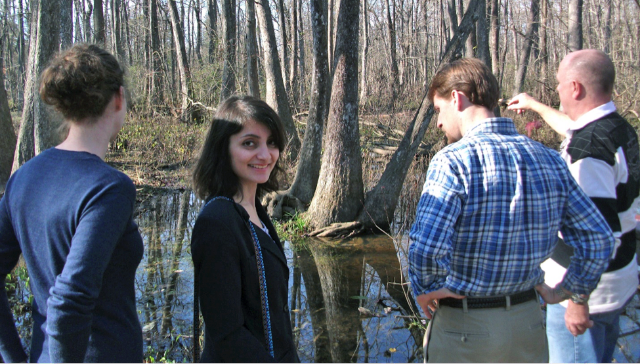On day three of my Ancient Greece tour, our group drove along the scenic coastal road to
Corinth and explored ancient Corinth, the
richest port of ancient Greece and also famous for its role in Christianity. On the way to Corinth, you will get to see the Corinth Canal which lies east of modern Corinth. The idea of building a canal through the Isthmus of Corinth (the small land part which connects the Peloponnese to the rest of Greece) was conceived by Periander, a tyrant of the sixth century BC. However, he never managed to make it due to financial and technical challenges. After a difficult history of conception and failed implementation, the canal was opened in July 1893, and open to navigation only until the following November, due to landslides. Now its open for cruises!
We didn't do a cruise and instead proceeded to Ancient Corinth, where most of the ancient ruins are, and this is approximately 5 kilometres (3.1 mi) southwest of the modern city. The ancient city is in good shape and has been left intact by the Romans when they redeveloped the city as their provincial capital in 44 BC.
One of the main sites at the ruins is the well-preserved Temple of Apollo with its massive Doric columns. The Temple lies on a low hill and dominates the entire ruin site. It was built around 540 BC, on the site of an earlier seventh-century-BC temple. Today, only seven monolithic limestone columns remain, but originally there would have been six along the front and back of the temple, and fifteen down each side.
Within this same area was the theater of Corinth which dates back to the late 5th c. B.C. It included fixed seats and a wooden stage. In the early 1st c. A.D., the gradient of the seats became steeper and a covered stoa (a walkway) was added to its upper part. During late Antiquity, theatrical aesthetics changed and the theater orchestra became a gladiators’ area.
We also saw the remains of the Roman temple attributed to Octavia, who was the sister of Augustus (1st century BCE). The temple was enclosed with Corinthian columns and built on a podium surrounded by stoas.
The ancient ruins of Corinth also include the Fountain of Peirene. The fountain is named for Peirene, a woman who wept so hard when she lost her son that she finally dissolved into the spring that still flows here. The first indications alluding to its use date back to the Neolithic period, while the first spatial configuration dates to the geometric and archaic period.
Peirene Fountain was an elaborate structure that served as a meeting place for Corinthians. The
arched openings led to bowls carved in the rock where water was collected.
Within the ruins was the Lechaion Road that once stretched from Corinth to the port Lechaion, hence its name. This ancient avenue devised out of 8 yards slabs of limestone made an effective means of transportation for all the citizens of Corinth.
Along the road is also the Bema of Saint Pail, who is also known as the Apostle of the Nations because of his missionary journeys throughout the eastern Mediterranean for the dissemination of Christianity. In this context he visited several Greek cities, including the island of Samothrace, Philippi, Thessalonica and Veroia in Macedonia, Athens and, most importantly, Corinth. Corinth, a Roman imperial colony and capital of the province of Achaea (Peloponnese and Central Greece), experienced a period of great prosperity during the Roman era. Saint Paul arrived in the city in the mid-1st c. A.D. and took up lodging and work with the Jewish tentmakers Aquila and Priscilla. At the same time, he reasoned and preached the Gospel to the Jews of the city, being confronted, however, with strong opposition from several members of the city’s large Jewish community. During Paul's stay in Corinth, he was brought for judgment before the proconsul Lucius Junius Gallio Annaeanus, also known as Gallio, on the accusation of conducting illegal teachings. Gallio, however, refused to judge what he considered to be a mere religious dispute among the Jews. According to tradition, the site of Paul's trial was the Bema, a large elevated rostrum standing prominently in the centre of the Roman Forum of ancient Corinth and from where the city's officials addressed the public. Probably because of the monument's connection to Saint Paul, the Bema was transformed into a Christian church during the Byzantine period.
Finally, after visiting the main site, we went to the Archaeological Museum of Corinth, which was small but where we saw this famous Sphinx from a funerary monument. Traces of painted decoration are preserved on the torso and the wings. Corinthian product, dated to the middle of the 6th century B.C.












0 comments